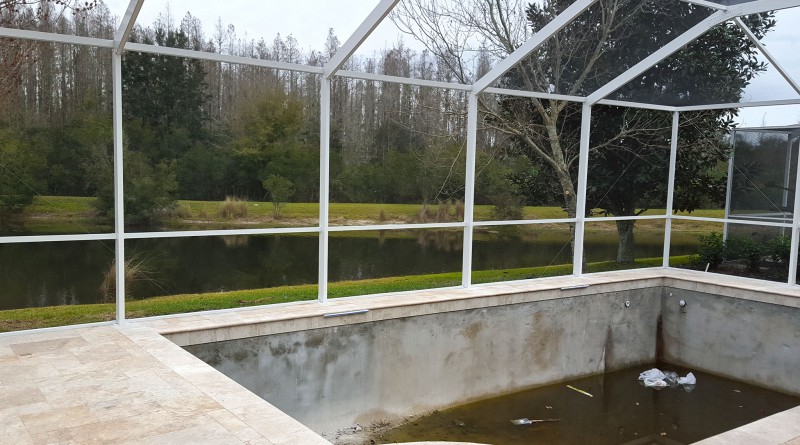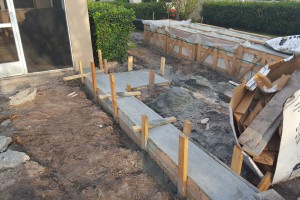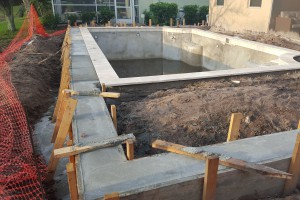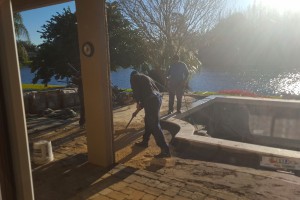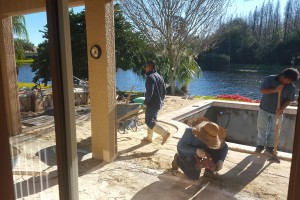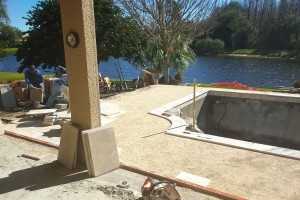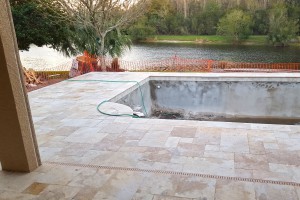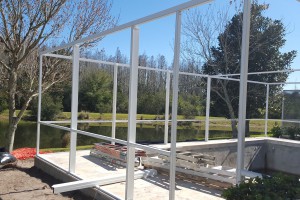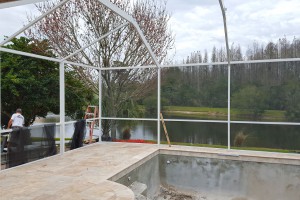What to expect when building an in ground pool – Part 5
Part 5 – Footer, Inspection, Patio, Enclosure
Key Points:
- The construction area is very unsafe during these stages, keep children and pets away
- There may be a delay in the build process as you wait for inspections
- Pavers are purchased by the pallet, so you may have a significant amount left over
- You may be able to save money on the enclosure by getting multiple bids.
Footer
In many cases, a footer will be required. The footer is a concrete border approximately 12 to 24 inches wide that is poured around the exterior of the pool/patio area. The depth of the footer will depend on the grade of your site and the design needs of your pool. The footer provides a strong stable surface to install a patio and an enclosure.
After the plumbing and electric around the pool are installed, a work crew will build wooden forms to shape the footer. The concrete used in this process is not sprayed on in layers like the shell of the pool, it is pumped into the top of the forms until they are full. Once the concrete cures, a crew will break away the wooden forms and ensure the footer is acceptable. Be careful around the construction site as these wooden forms will be splintered and contain exposed nails.
Inspection
At this stage, another inspection is required. There may be a delay in the building process as you wait for your local building inspector. The amount of time will depend on how quickly your pool builder notifies them that your site is ready and their workload. If there are any violations, the building inspector will notify your pool builder so they can make corrections. Once the inspection is passed, the builder can begin installing the patio.
Patio
Depending on the type, size, and the complexity of your patio, the installation time can vary significantly; however, you will probably be amazed at how fast experienced crews can get the job done.
The installation process will depend on the type of patio you choose, concrete or pavers. Either way, they will begin by leveling the area as much as possible using a vibrating plate compactor. A dump truck will arrive some time before the installation crew to deliver a load of sand and possibly small rock to be used in the process.
Concrete
For a concrete patio, the crew will build forms for each of the sections which will be filled by pumping the concrete mixture into the form(s) until they are full. This is a similar process to building the footer. Once the forms are full, workers will level off and remove any excess concrete. They will smooth the surface and apply any stamps or textures that you have requested. The concrete will need to cure (harden) before you can walk on the surface or add an enclosure. Additional steps, such as painting, chemical curing, or sealing may also be necessary for your patio.
Paver
A paver patio is made up of numerous pavers, which are pieces of concrete or stone. Pavers come in all shapes, colors, sizes, and materials available at Merritt Supply, so your options are only limited by your designer and budget.
The paver crew will spend additional time to ensure the area is level, since any variation will be visible in the patio surface. They will lay your pavers in the pattern that you have chosen, covering the entire area of the patio. If necessary, they will cut or shape pavers to fit edges, corners, or smaller areas. When all of the pavers are set, sand will be swept in the cracks between the pavers to help keep them from moving. In the years to come, you may have to sweep additional sand into the cracks or under pavers to keep them level and stable. Unlike a concrete patio, a paver patio can usually be used immediately since there is no curing process.
Pavers are usually purchased by the pallet, so you may have a significant amount left over after your patio is complete. Plan ahead by considering additional projects. If you have enough left over, the work crew may be able to install them while on site. There will probably be an additional cost and this will depend on your contractor.
Enclosure
In Florida, many homeowners choose to build a screen enclosure around their pool/patio area. An enclosure will help keep pests and debris from entering the patio area. If you live in a community with a Home Owners Association, be sure the style and color of your enclosure are a part of the approval process when having your pool design reviewed.
If your pool builder will allow you to select the contractor installing your enclosure, you may be able to lower your cost by getting multiple bids. Costs for enclosures can vary greatly from one contractor to another.
The installation of your enclosure can begin once the concrete has cured, or the paver patio is complete. The contractor will be mounting the base of the enclosure directly to the patio. They will arrive with long aluminum beams of various widths to build the frame and rolls of screen to fill in the walls. The aluminum beams are cut to the proper size and put together with screws and brackets. After the enclosure frame is constructed they will cover the walls and ceiling areas with sheets of screen. The installation process will usually take a day or two, but may be longer for larger or complex enclosures. The enclosure will need to be grounded with the pool’s electrical system for safety. Be sure to verify this with your contractor. If it is not done properly, your pool will fail the next inspection. There may be small pieces or shards of aluminum on the patio left from the building process. Consider sweeping the area if you are going to be walking on the patio.

